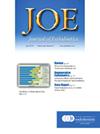Patient-Centered Outcome Assessment of Static and Dynamic Navigation-Aided Endodontic Microsurgery: A Randomized Controlled Trial
IF 3.5
2区 医学
Q1 DENTISTRY, ORAL SURGERY & MEDICINE
引用次数: 0
Abstract
Introduction
This study aimed to evaluate the quality of life (QoL) and analgesic use 1 week after surgery, as well as the surgical duration, associated with static navigation (SN) and dynamic navigation (DN)-aided endodontic microsurgery (EMS).
Methods
Sixty patients were randomly assigned to the SN group (n = 30) or the DN group (n = 30). Both groups underwent EMS based on a presurgical plan. The primary outcomes were patient-reported QoL and analgesic use during the first week, while the secondary outcome was the duration of guided procedures, including osteotomy and root-end resection. QoL was assessed using a visual analog scale-based questionnaire. The questionnaire evaluated symptoms (pain, swelling, bleeding) and functional impact (mouth opening, chewing, talking, sleeping, daily routine), with average scores for each component calculated daily. The Mann–Whitney U test was used to compare QoL scores and surgery duration between groups, with statistical significance set at P < .05.
Results
Postoperative adverse reactions within the first week after SN- and DN-aided EMS were short-lived, peaking early in the postoperative period and gradually subsiding. No significant differences were observed in QoL or analgesic use between the SN and DN groups. Participants in the SN group had significantly shorter surgery duration compared to DN group.
Conclusion
Both SN and DN enable minimally invasive EMS with equivalent patient-centered outcomes, though SN demonstrates a significant advantage in reducing the duration of guided osteotomy and root-end resection. These findings provide patient-centered reference metrics to guide the selection between the 2 guided approaches in clinical practice.
静态和动态导航辅助牙髓显微手术以患者为中心的疗效评估:一项随机对照试验。
前言:本研究旨在评价静态导航(SN)和动态导航(DN)辅助牙髓显微手术(EMS)对术后1周患者的生活质量(QoL)、镇痛药使用情况及手术时间的影响。方法:60例患者随机分为SN组(n=30)和DN组(n=30)。两组均接受了基于术前计划的EMS。主要结果是患者报告的生活质量和第一周的止痛药使用情况,而次要结果是指导手术的持续时间,包括截骨和根尖切除。使用基于视觉模拟量表的问卷评估生活质量。问卷评估症状(疼痛、肿胀、出血)和功能影响(张嘴、咀嚼、说话、睡眠、日常生活),每天计算每个组成部分的平均分。采用Mann-Whitney U检验比较各组间生活质量评分及手术时间,P < 0.05为差异有统计学意义。结果:SN组患者手术时间明显短于DN组。SN和dn辅助EMS术后第一周内的不良反应是短暂的,在术后早期达到高峰并逐渐消退。SN组和DN组在生活质量和镇痛药物使用方面无显著差异。结论:SN和DN都能实现微创EMS,具有相同的以患者为中心的结果,尽管SN在减少引导截骨和根端切除术的持续时间方面具有显着优势。这些发现为临床实践中两种指导方法之间的选择提供了有价值的以患者为中心的参考指标。
本文章由计算机程序翻译,如有差异,请以英文原文为准。
求助全文
约1分钟内获得全文
求助全文
来源期刊

Journal of endodontics
医学-牙科与口腔外科
CiteScore
8.80
自引率
9.50%
发文量
224
审稿时长
42 days
期刊介绍:
The Journal of Endodontics, the official journal of the American Association of Endodontists, publishes scientific articles, case reports and comparison studies evaluating materials and methods of pulp conservation and endodontic treatment. Endodontists and general dentists can learn about new concepts in root canal treatment and the latest advances in techniques and instrumentation in the one journal that helps them keep pace with rapid changes in this field.
 求助内容:
求助内容: 应助结果提醒方式:
应助结果提醒方式:


